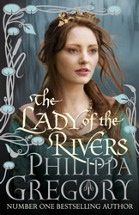The Lady of the Rivers by Philippa Gregory

Simon and Schuster, 2011. ISBN 9781847374592.
(Age: Senior students) Recommended. The Lady of the Rivers
by Philippa Gregory is historical fiction set in the mid to late
15th century in both English-held France and England. The main
character, Jacquette, is chosen by the Duke of Bedford as his new
wife because of her ability to scry, or foretell the future. The
Duke is insistent on preserving her virginity, an apparently
indisputable aid in alchemy. Young and beautiful, Jacquette falls in
love with the Duke's squire, the handsome Richard Woodville, and
despite her status as a duchess, marries him when the Duke dies.
Jacquette and her husband become trusted advisors to Henry VI, the
Lancastrian king, when Henry marries the French Margaret of Anjou.
The novel shows the increasing turbulence in England between the
nobility, resulting in the Wars of the Roses, and the eventual loss
of most of England's French lands. Henry lapses into near imbecility
and religious fervour, allowing Margaret to act cruelly to protect
the interests of her young son. Richard, now Lord Rivers, and his
son are avowed Lancastrians but after many weary battles are
eventually forced to surrender to the young Yorkist, Edward March
who becomes Edward IV. Conveniently, at the end of the novel Edward
is about to fall in love with and secretly marry Jacquette's eldest
daughter Elizabeth, thus assuring the Woodville family of power and
influence in his court. The author manages to combine historical
accuracy with story-telling flair. The personalities are convincing
and the action moves quickly. Queen Margaret's development into a
cruel and militaristic force is believable. While Jacquette's
abilities and influence are romanticized and the language is at
times jarringly anachronistic this is popularised history and as
such very readable.
Jenny Hamilton